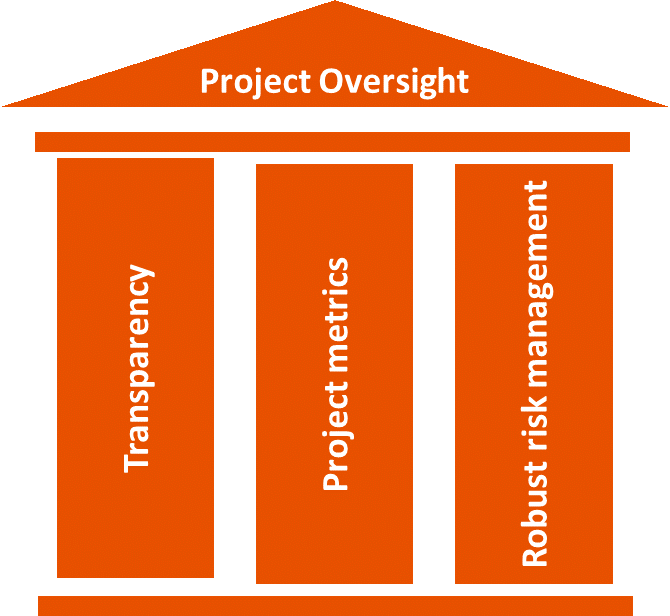The importance of strong and effective project oversight to project success
Nuclear projects are large and large projects are hard. They are hard to organize, and they are hard to execute. We have seen what happens when we try and convince people they are easy – or that we can make them easy by shifting the risk onto the vendor/contractor – and then expect everything to turn out all right. The outcome is either a project that is cancelled before it starts, or that runs over budget and over schedule.
Last year we did a three-part series on how to manage nuclear costs. We focused the discussion on how to build to cost and schedule, how to control the cost of capital and finally, how to control the capital cost. Today we are going to focus on an essential element of managing large projects to cost and schedule – project oversight. Project oversight can mean both the direct project management of a project, as well as the indirect and independent oversight that may be put in place by project investors or customers. In all cases, the need is the same. We must make sure projects are well managed and proper oversight plays an essential role in meeting this objective.
The purpose of project oversight is to ensure the project is proceeding on time and on budget – and of more importance, that problems are identified early so that corrective action may be taken while the cost to correct the issues are manageable. In our work on various nuclear projects we have identified a set of three pillars for successful project oversight:

Transparency – Transparency incentivizes good behaviour. The owner and other stakeholders must all have complete transparency through to every project detail. Once there is project transparency, it becomes clear that all project participants must line up with the same objective, completing the project successfully. Don’t listen to contractors that say they are taking a firm price so you can’t see the project details – no matter what the contractual model, there can be no secrets when it comes to project progress. This is the only way to see issues early and then take decisive action to resolve them quickly and efficiently. Otherwise, there will be delays as the contractor will only approach the owner for assistance after all other efforts have failed, greatly increasing the cost of correcting the issue and adding time that cannot be recovered.
A strong set of project metrics – numbers don’t lie, people do. The next step adding to transparency is to base project reporting on a clear unambiguous set of project metrics. These metrics must be kept current and be used to assess real project progress. If there has been poor progress in the past period, the metrics will show it, but more importantly, force a realistic recovery plan. We have all seen reports that say things were slow last week but will be made up next week – but the numbers show that this is not possible without adding resources i.e. to make up time, you need enough people to do the planned work for the next period AND the additional work that is behind. Metrics keep the project on track and demonstrate where there are issues that need attention, and then whether the attention is having the desired impact.
A robust risk management plan – we don’t create confidence by being told not to worry and that everything is under control; rather we want to know the risks are well understood and that a mitigation plan is in place should they be realized. Large projects will have things go wrong. It is inevitable. It is what we do about it and how well prepared we are that will make the difference on the project outcome.
All big projects are hard; nuclear projects are not unique. Clear precise reporting is an important element to understand project status and take action for project improvement. We have all been on projects that have “what I did on my summer vacation” type reporting telling us what has been achieved in the last period without providing context. This will not get the job done. However, if a project has adequate oversight based on these three pillars, it has the tools in place necessary for project success. Remember, success means finding ways to manage and mitigate risk, not pretending it doesn’t exist because it has been passed on to specific project participant making it their problem. As we have said many times, there are no scenarios where your contractor fails, and you succeed.
Nuclear plants have an important role to play in our current and future energy mix. To properly play its part requires projects to be economic with predictable outcomes. If we do our part to demonstrate we can deliver on our commitments, we can then work to secure more support from our stakeholders, and of most importance, the public.





2 Comments
Mark Lesinski · January 26, 2019 at 12:23 pm
Hi Milt,
Another great reminder on how we can up our game in project delivery. By going back to the foundation of sound basics, as this article describes, we can improve our delivery locally and improve our industries reputation of on time and on schedule delivery. If our industry is going to make the positive world wide impact that is needed, our current trust level must improve and delivering what we say we will is huge. Keep up the good work with these pertinent topics.
Thanks.
Bob Strickert · January 26, 2019 at 3:30 pm
Hi Milt- Well done- as always you get to the essence of the issues.
Comments are closed.